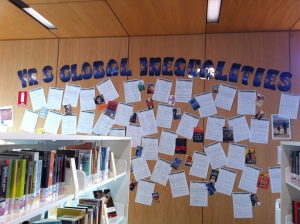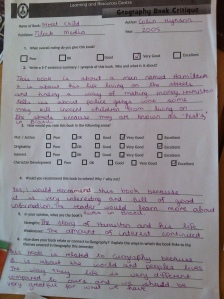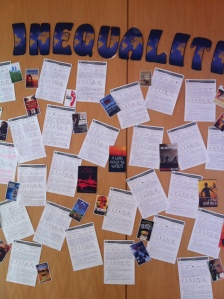Part of my role as a teacher-librarian is to collaborate with teachers in the development of literature-based reading programs. Usually, this occurs within the English curriculum so when the opportunity arose to do so in the context of the Geography classroom, I jumped at the chance for cross-curricular literature integration.
It all started last year when an innovative Geography teacher on staff approached me a week before the winter holidays, asking if I could put together a book box of fiction titles for her year 8 Geography class. She was after texts that in one way or another touched on the topic of Global Inequalities, a year 8 unit under the syllabus focus area of Global Change. Within this unit, students look at extremes of poverty and wealth, variations in access to essential aspects of life such as education, food, shelter and health care, and different life opportunities and quality of life throughout the world. She wanted to widen her students’ exposure to the topics they’d learned about in Geography and saw fiction as one way of doing this. The aim was for the girls to read their fiction text over the school holidays and be ready to tell the class about it at the start of the following term.
The Geography Wide Reading initiative was so successful that this year all three year 8 Geography classes wanted to take part. In collaboration with Geography staff, we formalised the structure of the activity and incorporated a written book critique to be displayed in the Learning Resources Centre, which functioned as both a showcase of student learning and a book promotion tool.
Here’s how we did it:
1. Compiled a list of book titles relating to the themes / ideas related to the Global Inequalities unit.
2. Used a ‘Speed Dating’ approach for book selection:
- Provided students only a photocopy of the first page of each book to base their initial selection on (so they didn’t judge the book by its cover!).
- If students liked their ‘date’ based on these first few minutes of interaction, they were given the book to continue the ‘conversation, which now included reading a few more pages, examining the cover and reading the blurb on the back of the book.
- Asked students to give their ‘date’ a fair chance by reading pages equaling their age and a page, so for year 8 girls this meant 13-15 pages.
- Gave students three days after their initial choice to change their minds and borrow another title from the selected list.
3. Allowed students a two week timeframe to read their chosen book, including time in class.
4. Provided students with a Book Critique template to rate aspects of the book and comment on their reading experience in the context of their learning in Geography.
5. Asked the students to use the Book Critique display in the Learning Resources Centre to choose a second book to read over the holidays.
Teacher and student feedback voted the project a successful and enjoyable experience, allowing students to examine concepts studied in Geography through a literary lens.
Can’t wait to do it again next year!
Have any of you had experience with Wide Reading initiatives in subjects other than English? I’d love to hear about them.




I would love to do this on a formal basis. In my classroom teaching, and while I was studying to be a TL, I would introduce my students to this kind of wider reading, and I do it frequently on an informal basis with English and Humanities classes now I am working as a TL. Well done, Katharina!
Hi Katie, why not approach some of your humanities staff with the idea? Suggest it as a holiday wide reading project at first. This way there is minimal impact on class time with only one lesson choosing the books and another one discussing the critique sheets. Happy to share any materials with you.